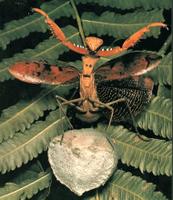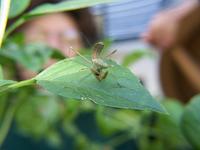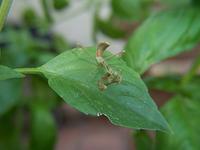I guess they don't eat their heads after all...dang!
 ***Please click photos for larger view-read mouse-overs too***
***Please click photos for larger view-read mouse-overs too***SANTA CRUZ, CALIF-Male praying mantises don't lose their heads over females after all. Videotapes taken by biologists at the University of California show that female praying mantises do not decapitate their male partners prior to copulation--a misconception that has held on for nearly 200 years. According to Eckehard Liske and W. Jackson Davis, the male mantis performs a ritual dance and the female, instead of attacking her mate, responds with a dance of her own. Neither dance had ever before been observed by scientists. While the
 female's dance begins with a menacing stance, it ends with a nonthreatening posture signaling her receptiveness. "It's really a lovely display," says Davis. The problem with previous studies, says Davis, was privacy. Apparently the adagio had never been witnessed before because the mantises were distracted by the well-lit scientists watching them. Davis and Liske observed the insects, which were put under bright lights, from a darkened room.
female's dance begins with a menacing stance, it ends with a nonthreatening posture signaling her receptiveness. "It's really a lovely display," says Davis. The problem with previous studies, says Davis, was privacy. Apparently the adagio had never been witnessed before because the mantises were distracted by the well-lit scientists watching them. Davis and Liske observed the insects, which were put under bright lights, from a darkened room. Another reason for the headless lover theory, according to Davis, is that in previous studies researchers simply haven't given enough food to their subjects. A female mantis eats up to 15 fullgrown crickets a day and is usually more hungry than amorous. These experimental problems had led researchers to believe that the male mantis could offer a sexual response only after the brain was removed, a reflex similar to a chicken running with its head cut off. Now, Davis is happy to report, "the male mantis performs quite well with his head in place." Mating with a female praying mantis, top photo, is a lot easier on the male mantis than previously believed.
Another reason for the headless lover theory, according to Davis, is that in previous studies researchers simply haven't given enough food to their subjects. A female mantis eats up to 15 fullgrown crickets a day and is usually more hungry than amorous. These experimental problems had led researchers to believe that the male mantis could offer a sexual response only after the brain was removed, a reflex similar to a chicken running with its head cut off. Now, Davis is happy to report, "the male mantis performs quite well with his head in place." Mating with a female praying mantis, top photo, is a lot easier on the male mantis than previously believed.--From Science Magazine Feb. 1985.

1 Comments:
This is a great story... but why did you change the name of the blog? "Pillblooms" is so poetic.
Post a Comment
<< Home